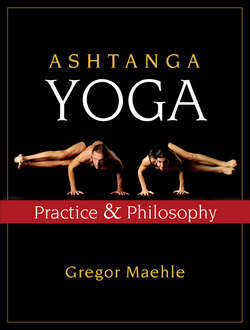Читать книгу Ashtanga Yoga - Gregor Maehle - Страница 231
На сайте Литреса книга снята с продажи.
Vinyasa Seven
ОглавлениеInhaling, jump through to sitting and straighten the legs. An experienced practitioner would go into the posture in one breath. For the sake of precision and safety we will break this rather complex movement down into various phases, identical to the standing half lotus (Ardha Baddha Padmottanasana).
PHASE 1
Sitting in Dandasana, flex the right knee joint completely until your right heel touches the right buttock. If this is not possible, resort to daily practice of Virasana and Supta Virasana. (See “Lengthening the Quadriceps,” page 57.)
PHASE 2
From here abduct the right thigh until the right knee touches the floor. Establish a 90° angle between the thighs. Pointing and inverting the right foot, draw the right heel into the right groin, or as close to it as possible. You are now in the position for Janushirshasana A (page 79). Transiting through this posture on the way into half lotus prepares the adductor muscle group. Keeping the foot pointed and inverted, draw the knee far out to the right to further stretch the adductors. Tight adductors constitute the main obstacle to lotus and half-lotus postures. This method gives beginners maximum opening. It is not recommended that beginners pull the foot into position without first releasing the adductors. This movement can be repeated several times to produce the desired effect.
PHASE 3
Draw the heel in toward the navel. Transiting via the navel on the way into half lotus will ensure that the knee joint remains sealed.
PHASE 4
Now draw the right foot across to the left groin. Reach your right arm around your back to bind the right big toe. The palm faces downward. The palm facing up would lead to excessive inward rotation of the humerus and, with it, hunching of the shoulder. An inability to bind is often due to stiffness in the right shoulder because of a short pectoralis minor muscle (see figure 13, page 76). In this case reach the right arm far up and out to the right side. Spin the arm inward so that the palm faces backward. Reach far behind, lowering the hand. Abduct and depress the shoulder girdle to avoid jutting the shoulder forward. As you proceed, release the muscle that draws the shoulder forward (pectoralis minor). If you still cannot reach the toe, work intelligently in Parshvottanasana, Prasarita Padottanasana C, Urdhva Dhanurasana, and Upward and Downward Dog. These postures reduce tightness in the shoulders.
